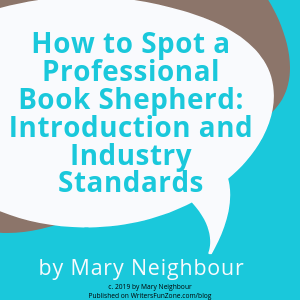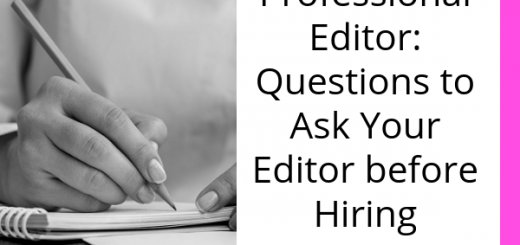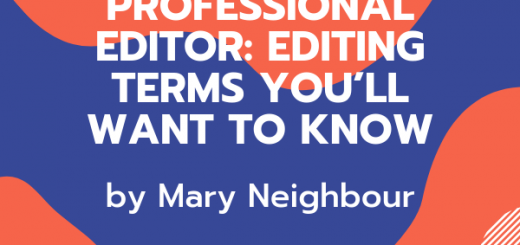How to Spot a Professional Book Shepherd: Introduction and Industry Standards by Mary Neighbour
 Please welcome back guest author Mary Neighbour as she shares with us “How to Spot a Professional Book Shepherd: Introduction and Industry Standards.” Enjoy!
Please welcome back guest author Mary Neighbour as she shares with us “How to Spot a Professional Book Shepherd: Introduction and Industry Standards.” Enjoy!
***
After the writing, after the editing, after the designing of the book, authors are faced with actually publishing their books; that is, making a physical and/or digital book available for readers, distributors, libraries, and/or booksellers.
Manufacturing and producing a physical product is—you guessed it—complex, entailing far more than handing off a file to an online publishing platform or commercial printer.
Self-publishers at this point may seek the help of a freelancer who has experience in the printing, binding, and manufacture of books.
Yet I would argue that the help you hire should be knowledgeable about all areas of publishing, regardless of how “hands-on” they are.
Why? Because the final book product is the sum of its parts, and you want someone who can assess the professionalism of each of those parts.
Book Shepherd
 Book shepherd is a common handle for such an overall publishing consultant, though you’ve likely heard book doctor, book guru, and others.
Book shepherd is a common handle for such an overall publishing consultant, though you’ve likely heard book doctor, book guru, and others.
They all refer to full-service consultants who have the expertise to guide you along any or every mile of the publishing journey.
Even if you only engage this professional after the editing and design are finished, I advocate bringing them onboard for the finalization of the publishing process.
This type of professional is knowledgeable about all aspects of publishing—and there are many aspects to consider:
Aspects of Book Publishing
- Editing, design, and layout
- What belongs in the front and back matter, what belongs on the cover, etc. In short, is everything where it needs to be?
- Rights, permissions, disclaimers, and ISBN
- Creating digital files for ebooks, uploads, and delivery to service providers
- Printing and binding
- Proofs and review copies
- Business plans, names, imprints, logos, domains, and websites
- Pricing, bar codes, EAN, and ASIN
- Researching and selecting keywords, categories, PCIP, audiences, competition, reviews, and endorsements
- Author goals, platforms, and book launch
- Marketing and promotion
- Distribution, discovery, delivery, and discounts
We’ve covered some of these topics in detail, in previous blog posts. Now we’ll zoom out and review the publishing process as a whole, integrated, strategic process.
Publishing Process as a Whole, Integrated, Strategic Process
The book shepherd who manages this operation fundamentally needs to be someone who has their finger on the pulse of the industry, which changes and updates regularly in this vigorous digital age.
They also need to be able to work within budget and within deadline, so communication with you must be clear, supportive, and instructive.
Book Publishing Industry Standards: What A Book Shepherd Knows
Many aspects of the publishing industry will change position and move to greener pastures over time. But the fundamental standards remain terra firma.
Assuming that the actual writing of the book is up to par in terms of grammar and style, the following standards should be followed to ensure your book is a class act, from your desktop all the way to the reader’s hands.
Standard #1
A professional book adheres to
(a) the norms of its genre—in presentation and production—and also to
(b) the purpose of its content, so that a reader can easily understand and navigate the book’s content.
Standard #2
A professional book is edited, designed, and produced by industry experts. (See all previous blogs in this series for details.)
A physical proof of the book is carefully reviewed to ensure this. The review of the proof includes factors of content accuracy and legibility, binding durability, as well as ink and paper quality.
Standard #3
A professional book displays appropriate title page(s) and copyright page.
Standard #4
The author or publisher owns the ISBN. Books intended for retail sales have a barcode. Complete and consistent metadata is used with every vendor and service provider, by whatever means the book is manufactured.
Standard #5
A professional book is released into the marketplace in a strategic manner at a strategic time. It is competitive within its genre.
Standard #6
By its very nature, publishing is collaborative, making it one of the most fulfilling professional experiences for all involved.
 Moreover, the guardianship of books carries significant social responsibilities. Make sure all the sheep in your care are properly sheltered before a storm hits.
Moreover, the guardianship of books carries significant social responsibilities. Make sure all the sheep in your care are properly sheltered before a storm hits.
Ethical Standard for A Book Shepherd (and Other Book Professionals)
Incumbent upon authors, publishers, book shepherds, freelancers, and consultants is the duty to uphold basic ethics.
Many publishing houses make their ethical standards public. However, where do self-publishers go for information on this important topic?
No doubt you have heard the criticisms about vanity and some subsidy presses who not only may be inexpert, they place profit (theirs) above any other consideration.
Self-serving exploitation has no place in publishing, such as:
- Plagiarism or failure to accurately cite sources
- Fabrication or falsification of data (text or images)
- Bias regarding sex, race, beliefs, ethnic origin, etc.
- Lack of confidentiality, when appropriate
- Failure to disclose a conflict of interest
The University of Chicago Press wrote a survey-based article, “Ethical Problems in Book Publishing,” which stresses quality in four prominent areas: “… quality in all editorial and production processes, for handling morally the tensions between authors and editors, for treating support personnel fairly, and for promoting materials truthfully.”
Pretty good guidelines! In addition to upholding these industry standards, my own ethics are inspired by the advice of Felix Adler:
Act so as to elicit the best in others and thereby in thyself.
***
Next week in this series: “Publishing Terminology You’ll Want to Know.”
The following week: “Telltale Signs Your Book Shepherd Is a Publishing Professional.”
***
ABOUT THE AUTHOR
 Some call Mary E. Neighbour a “book shepherd,” though Mary wields a blue pencil far more expertly than a herding rod. For the past ten years, she and her husband have helped dozens of writers bring their manuscripts to the marketplace, through MediaNeighbours, their publishing services business.
Some call Mary E. Neighbour a “book shepherd,” though Mary wields a blue pencil far more expertly than a herding rod. For the past ten years, she and her husband have helped dozens of writers bring their manuscripts to the marketplace, through MediaNeighbours, their publishing services business.
Passionate about helping authors make their work shine in the world, with a combined professional expertise of over 50 years in editing and design, this family team is one you’ll want to adopt as your guide through the challenging world of independent publishing.
Mary’s other passion is learning about the history of slavery and how it impacts race relations today. She incorporated much of her research into her novel, Speak Right On: Conjuring the Slave Narrative of Dred Scott






